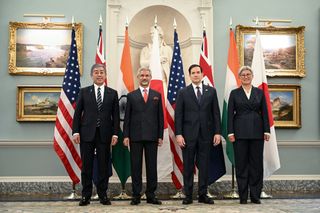Trump administration officials speak often of the responsibility of US allies and partners to do more for the common defence.
The good news for Washington is that most of those countries agree. This is particularly true in Asia, where Australia, India, Japan and South Korea are increasingly unsettled by Chinese maritime coercion. In response, they have sought to build-up their military capabilities and deepen their cooperation with the United States in the interests of preserving a favourable balance of power.
The Pentagon must account for what allies can and should contribute to the foundations of US military power.
Yet there are differences between the administration and its allies over how best to burden share. Trump’s team have touted larger and more timely Foreign Military Sales as their preferred means for doing so. But for many allies, simply buying US weaponry — much of which won’t arrive for years — is no longer enough. They want to help design and build it, too.
It’s in that context that the looming reform blitz at the Pentagon must account for what allies can and should contribute to the foundations of US military power.
The reality is that the United States needs the help of these same countries to develop and produce the very capabilities that it hopes they will purchase — let alone to meet the Trump administration’s goals of rebuilding the US defence industrial base.
Rarely has US defence industrial capacity and technological prowess been under such strain. The COVID-19 pandemic, Russia’s invasion of Ukraine and high-intensity operations in the Middle East have sapped Washington’s ability to meet both its own and its allies’ material defence needs. In Asia, these challenges are compounding with legacy maintenance and production shortfalls and with China’s growing ability to contest US military logistics, all of which pose serious challenges to the United States' long-term strategic position in the region.
It’s no coincidence, then, that defence industrial and technology cooperation has become central to modernising the United States' Indo-Pacific alliances.
Indeed, partners like Australia, India, Japan and South Korea are increasingly willing and able to make direct contributions to the industrial and technological foundations of US military power. This is exactly what defence innovation initiatives like AUKUS and INDUS-X, along with ship maintenance and munitions co-production agreements with all four countries, are intended to facilitate.
Trump’s team now have the chance to own that agenda.
The early signs have been encouraging. US Defense Secretary Pete Hegseth’s early engagements with his Australian and Indian counterparts and US Navy Secretary John Phelan’s recent visits to Japanese and Korean shipyards have reflected an appreciation of the role that allies can play in revitalizing the US defence industrial base, through making their world-beating technologies and production capacities available to the Pentagon.

But maximising these contributions will require reforming the ways in which the Pentagon develops and procures weaponry to make it easier for allies to work with Washington.
Fortunately, both Trump and Congress are clearly intent on doing just that. Trump’s 9 April executive order directed the Pentagon to submit plans for a “comprehensive overhaul” of relevant policy and workforce functions within the next 120 days. US Senate Armed Services Committee chairman Roger Wicker’s Fostering Reform and Government Efficiency in Defense (FORGED) Act similarly proposes a sweeping overhaul to regulations and policy settings governing the way that the Pentagon buys what it needs.
These proposals emphasise speed, flexibility and embracing commercially available solutions in the interests of outpacing Chinese and Russian military innovation and scale. But they leave it rather unclear as to where allies fit into these plans beyond buying what the United States is selling.
Continuing to overlook allied advantages would run contrary to the administration’s objective of bringing disruptive new players into the US defence industrial base. In other words, reforms to the Pentagon’s business practices would be incomplete without revisions to the ways in which the department works with allies and their companies, not just how they purchase US weaponry.
Reforms to the Pentagon’s business practices would be incomplete without revisions to the ways in which the department works with allies and their companies, not just how they purchase US weaponry.
At a minimum, this should include directives for US acquisition officials to actively consider allied solutions, particularly for priorities like AI, hypersonics, quantum and unmanned systems — all areas where US allies have plenty to offer. Reforms could also revisit contracting and tender processes that disadvantage non-US companies, and fine-tune export controls and information-sharing practices to encourage allies to more readily share their technologies without fear of losing control of them.
Trump could also revise US policy settings vis-a-vis international agreements like the Missile Technology Control Regime which limit what the US can arm its partners with and, perhaps more importantly, inhibit co-development and co-production initiatives through the likes of AUKUS.
Making it easier for allies to work with the Pentagon will make it easier for them to share the burdens of collective security in an increasingly insecure world. Australia, India, Japan and South Korea are ready and willing to do so, and support reforms to that end. But these efforts will only succeed if the Trump administration accounts for what these countries have to offer the United States' defence industrial base, not just what they might buy from it.









